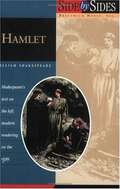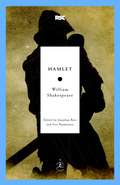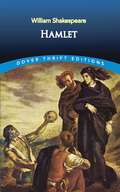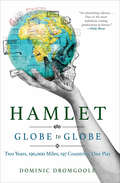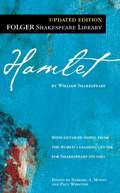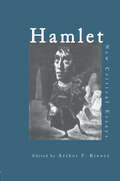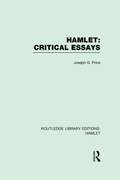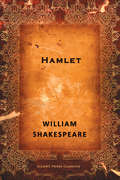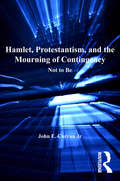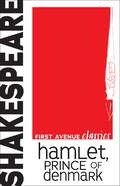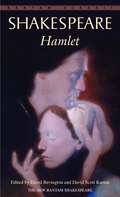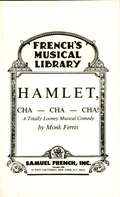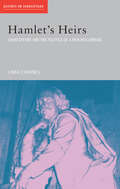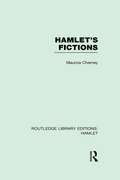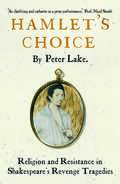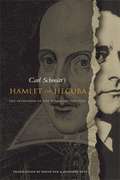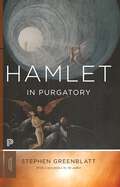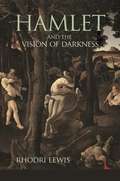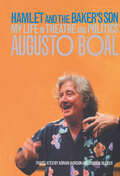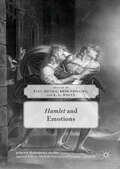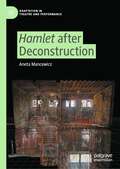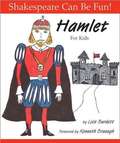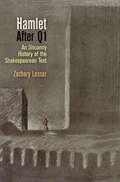- Table View
- List View
Hamlet: Side by Side
by William Shakespeare James ScottVisually engages readers by placing the original dialogue on the left-hand side of the page, and a modern prose interpretations on the right. As a result, it is easy for readers to cross reference as they move through the play and finally "get" Shakespeare.
Hamlet: Large Print (Modern Library Classics)
by William Shakespeare Jonathan Bate Eric RasmussenOne of the greatest plays of all time, the compelling tragedy of the tormented young prince of Denmark continues to capture the imaginations of modern audiences worldwide. Confronted with evidence that his uncle murdered his father, and with his mother's infidelity, Hamlet must find a means of reconciling his longing for oblivion with his duty as avenger. The ghost, Hamlet's feigned madness, Ophelia's death and burial, the play within a play, the "closet scene" in which Hamlet accuses his mother of complicity in murder, and breathtaking swordplay are just some of the elements that make Hamlet an enduring masterpiece of the theater.Each Edition Includes:* Comprehensive explanatory notes * Vivid introductions and the most up-to-date scholarship * Clear, modernized spelling and punctuation, enabling contemporary readers to understand the Elizabethan English* Completely updated, detailed bibliographies and performance histories * An interpretive essay on film adaptations of the play, along with an extensive filmography. [This text is listed as an example that meets Common Core Standards in English language arts in grades 11-12 at http://www.corestandards.org.]
Hamlet: Hamlet; Macbeth; Othello; Romeo And Juliet (Dover Thrift Editions)
by William Shakespeare<P>In this quintessential Shakespeare tragedy, a young prince's halting pursuit of revenge for the murder of his father unfolds in a series of highly charged confrontations that have held audiences spellbound for nearly four centuries. <P><P>Those fateful exchanges, and the anguished soliloquies that precede and follow them, probe depths of human feeling rarely sounded in any art. <P>The title role of Hamlet, perhaps the most demanding in all of Western drama, has provided generations of leading actors their greatest challenge. <P>Yet all the roles in this towering drama are superbly delineated, and each of the key scenes offers actors a rare opportunity to create theatrical magic. <P>As if further evidence of Shakespeare's genius were needed, Hamlet is a unique pleasure to read as well as to see and hear performed. <P>The full text of this extraordinary drama is reprinted here from an authoritative British edition complete with illuminating footnotes. <P>A selection of the Common Core State Standards Initiative.
Hamlet: Globe to Globe: Two Years, 190,000 Miles, 197 Countries, One Play
by Michael Gallagher Dominic DromgooleFrom the artistic director of Shakespeare’s Globe Theatre in London, an account of the theater’s extraordinary two-year tour bringing Hamlet to every country on earth
Hamlet: Drama En Tres Actes Y En Vers... (Folger Shakespeare Library)
by William ShakespeareHamlet is Shakespeare's most popular, and most puzzling, play. It follows the form of a "revenge tragedy," in which the hero, Hamlet, seeks vengeance against his father's murderer, his uncle Claudius, now the king of Denmark. Much of its fascination, however, lies in its uncertainties. Among them: What is the Ghost--Hamlet's father demanding justice, a tempting demon, an angelic messenger? Does Hamlet go mad, or merely pretend to? Once he is sure that Claudius is a murderer, why does he not act? Was his mother, Gertrude, unfaithful to her husband or complicit in his murder? The authoritative edition of Hamlet from The Folger Shakespeare Library, the trusted and widely used Shakespeare series for students and general readers, is now available as an eBook. Features include: · The exact text of the printed book for easy cross-reference · Hundreds of hypertext links for instant navigation · Freshly edited text based on the best early printed version of the play · Full explanatory notes conveniently placed on pages facing the text of the play · Scene-by-scene plot summaries · A key to famous lines and phrases · An introduction to reading Shakespeare's language · Illustrations from the Folger Shakespeare Library's vast holdings of rare books · An essay by a leading Shakespeare scholar providing a modern perspective on the play
Hamlet: Critical Essays (Shakespeare Criticism)
by Arthur F. KinneyUsing a variety of approaches, from postcolonialism and New Historicism to psychoanalysis and gender studies, the international contributors to Hamlet: New Critical Essays contribute major new interpretations on the conception and writing, editing, and cultural productions of Hamlet. This book is the most up-to-date and comprehensive critical analysis available of one of Shakespeare's best-known and most engaging plays.
Hamlet: Critical Essays (Routledge Library Editions: Hamlet)
by Joseph G. PriceA comprehensive collection of the best writing about this Shakespearian play, both as dramatic literature and theatrical performance, this book is an excellent resource companion to the text. This collected wisdom was originally published in 1986. It contains pieces of commentary from as far back as the late 18th Century but also highly acclaimed critical pieces from more recent years, organised into six general themes.
Hamlet: A Tragedy
by William ShakespeareHamlet is Shakespeare's most popular, and most puzzling, play. It follows the form of a "revenge tragedy," in which the hero, Hamlet, seeks vengeance against his father's murderer, his uncle Claudius, now the king of Denmark. Much of its fascination, however, lies in its uncertainties. Among them: What is the Ghost--Hamlet's father demanding justice, a tempting demon, an angelic messenger? Does Hamlet go mad, or merely pretend to? Once he is sure that Claudius is a murderer, why does he not act? Was his mother, Gertrude, unfaithful to her husband or complicit in his murder?
Hamlet, Protestantism, and the Mourning of Contingency: Not to Be
by John E. JrBuilding on current scholarly interest in the religious dimensions of the play, this study shows how Shakespeare uses Hamlet to comment on the Calvinistic Protestantism predominant around 1600. By considering the play's inner workings against the religious ideas of its time, John Curran explores how Shakespeare portrays in this work a completely deterministic universe in the Calvinist mode, and, Curran argues, exposes the disturbing aspects of Calvinism. By rendering a Catholic Prince Hamlet caught in a Protestant world which consistently denies him his aspirations for a noble life, Shakespeare is able in this play, his most theologically engaged, to delineate the differences between the two belief systems, but also to demonstrate the consequences of replacing the old religion so completely with the new.
Hamlet, Prince of Denmark: Hamlet (anglais Français Édition Illustré) (First Avenue Classics ™)
by William Shakespeare"Something is rotten in the state of Denmark." Brooding Hamlet, the son of the recently deceased king, is about to discover the royal family's corruption firsthand. Taken by the castle watchman to meet the apparition they see at night, Hamlet is surprised to find it is his father's ghost. Hamlet seeks to avenge his father's dishonorable death, but the casualties along the way may prove to be just as tragic. Enter William Shakespeare's famous world of betrayal, madness, and "murder most foul" through this unabridged version of Hamlet, Prince of Denmark, first published in England in 1603.
Hamlet, Prince of Denmark
by William Shakespeare David Bevington David Scott KastanThis is an EXACT reproduction of a book published before 1923. This IS NOT an OCR'd book with strange characters, introduced typographical errors, and jumbled words. This book may have occasional imperfections such as missing or blurred pages, poor pictures, errant marks, etc. that were either part of the original artifact, or were introduced by the scanning process. We believe this work is culturally important, and despite the imperfections, have elected to bring it back into print as part of our continuing commitment to the preservation of printed works worldwide. We appreciate your understanding of the imperfections in the preservation process, and hope you enjoy this valuable book.
Hamlet, Cha Cha Cha!
by Monk FerrisMusical / 7m, 4f, plus chorus / Totally insane. And totally hilarious. You all know the story of Hamlet-- but never has a plot line been followed by such gleefully drunken footsteps, singing all the way! can you envision Horatio as "an amiable sponge" always seeking the nearest buffet table? Can you see Gertrude and Claudius, married on their way home from King Hamlet's funeral, leading the opening number of the show, "Boo Hoo! I Do!"? Or picture the soliloquy done by Prince Hamlet with a back up male chorus chanting "Doo waaah!" at inappropriate intervals? And how about Queen Gertrude, backed up by the female chorus [the "Elsinoritas," of course], telling Laertes about Ophelia's dreadful death in a hand clapper called "Down, Down, Down the River!"? And will you recognize Hamlet's two college chums, herein known as "Rosie Krantz" and "Gilda Stern"? And if you think you know the way the story turns out-- you don't. Not in this version, anyhow. Believe us, if you've always hated Shakespearean plays, you'll love this show-- but paradoxically, you've always loved Shakespearian plays, you'll love this show despite yourself.
Hamlet's Heirs: Shakespeare and The Politics of a New Millennium (Accents on Shakespeare)
by Linda CharnesSpeaking to readers in a voice that is adventurous rather than authoritative, innovative rather than institutional and speculative rather than orthodox, Linda Charnes’ provocative study of Shakespeare’s legacy in contemporary American and British politics explores the following themes: namesake princes and presidents stolen thrones and elections plutocrats and insurgents campaign trails and war-mongering waning monarchy and imperilled democracy revengers, early modern and postmodern. Linked by focused readings of Hamlet and the Henriad, the essays follow Shakespeare’s two most famous royal sons, the Princes Hamlet and Hal, as they haunt contemporary political psychology in the early years of a new millennium, and especially in the aftermath of September 11, 2001. Between devolution in Britain and the new ‘doctrine’ of pre-emptive strike in the United States, our contemporary Hamlets and Hals epitomize a debate – as fraught now as in Shakespeare’ day – about the cost of spin-doctoring legacies. In exploring how current political culture inherits Shakespeare, Hamlet’s Heirs challenges scholarly assumptions about historical periodicity, modernity and the uses of Shakespeare in present day contexts.
Hamlet's Fictions (Routledge Library Editions: Hamlet)
by Maurice Charney"But in a fiction, in a dream of passion..." In an extended commentary on this passage this book offers a rationale for the excellence and primacy of this play among the tragedies. Throughout, emphasis is placed on Hamlet's fantasies and imaginations rather than on ethical criteria, and on the depiction of Hamlet as a revenge play through an exploration of its dark and mysterious aspects. The book stresses the importance of Passion and Its Fictions in the play and attempts to explore the very Pirandellian topic of Hamlet's passion and dream of passion. It goes on to examine the organization of dramatic energies in the play - the use Shakespeare makes of analogy and infinite regress and of scene rows, broken scenes and impacted scenes, and the significance of the exact middle of Hamlet. The final section is devoted to conventions of style, imagery, and genre in the play - what is the stage situation of asides, soliloguies, and offstage speech? How is the imagery of skin disease and sealing distinctive? In what sense is Hamlet a comedy, or does it use comedy significantly?
Hamlet's Choice: Religion and Resistance in Shakespeare's Revenge Tragedies
by Peter LakeAn illuminating account of how Shakespeare worked through the tensions of Queen Elizabeth&’s England in two canon-defining plays Conspiracies and revolts simmered beneath the surface of Queen Elizabeth&’s reign. England was riven with tensions created by religious conflict and the prospect of dynastic crisis and regime change. In this rich, incisive account, Peter Lake reveals how in Titus Andronicus and Hamlet Shakespeare worked through a range of Tudor anxieties, including concerns about the nature of justice, resistance, and salvation. In both Hamlet and Titus the princes are faced with successions forged under questionable circumstances and they each have a choice: whether or not to resort to political violence. The unfolding action, Lake argues, is best understood in terms of contemporary debates about the legitimacy of resistance and the relation between religion and politics. Relating the plays to their broader political and polemical contexts, Lake sheds light on the nature of revenge, resistance, and religion in post-Reformation England.
Hamlet or Hecuba: The Intrusion of the Time into the Play
by Carl Schmitt David Pan Jennifer R. RustHamlet or Hecuba by Carl Schmitt provides an innovative and insightful analysis of Shakespeare's tragedy in terms of the historical situation of its creation.
Hamlet in Purgatory: Expanded Edition (Princeton Classics #4)
by Stephen GreenblattIn Hamlet in Purgatory, renowned literary scholar Stephen Greenblatt delves into his longtime fascination with the ghost of Hamlet's father, and his daring and ultimately gratifying journey takes him through surprising intellectual territory. It yields an extraordinary account of the rise and fall of Purgatory as both a belief and a lucrative institution--as well as a capacious new reading of the power of Hamlet. In the mid-sixteenth century, English authorities abruptly changed the relationship between the living and dead. Declaring that Purgatory was a false "poem," they abolished the institutions and banned the practices that Christians relied on to ease the passage to Heaven for themselves and their dead loved ones. Greenblatt explores the fantastic adventure narratives, ghost stories, pilgrimages, and imagery by which a belief in a grisly "prison house of souls" had been shaped and reinforced in the Middle Ages. He probes the psychological benefits as well as the high costs of this belief and of its demolition. With the doctrine of Purgatory and the elaborate practices that grew up around it, the church had provided a powerful method of negotiating with the dead. The Protestant attack on Purgatory destroyed this method for most people in England, but it did not eradicate the longings and fears that Catholic doctrine had for centuries focused and exploited. In his strikingly original interpretation, Greenblatt argues that the human desires to commune with, assist, and be rid of the dead were transformed by Shakespeare--consummate conjurer that he was--into the substance of several of his plays, above all the weirdly powerful Hamlet. Thus, the space of Purgatory became the stage haunted by literature's most famous ghost. This book constitutes an extraordinary feat that could have been accomplished by only Stephen Greenblatt. It is at once a deeply satisfying reading of medieval religion, an innovative interpretation of the apparitions that trouble Shakespeare's tragic heroes, and an exploration of how a culture can be inhabited by its own spectral leftovers. This expanded Princeton Classics edition includes a new preface by the author.
Hamlet and the Vision of Darkness
by Rhodri LewisAn acclaimed new interpretation of Shakespeare's HamletHamlet and the Vision of Darkness is a radical new interpretation of the most famous play in the English language. By exploring Shakespeare's engagements with the humanist traditions of early modern England and Europe, Rhodri Lewis reveals a Hamlet unseen for centuries: an innovative, coherent, and exhilaratingly bleak tragedy in which the governing ideologies of Shakespeare's age are scrupulously upended. Recovering a work of far greater magnitude than the tragedy of a young man who cannot make up his mind, Lewis shows that in Hamlet, as in King Lear, Shakespeare confronts his audiences with a universe that received ideas are powerless to illuminate—and where everyone must find their own way through the dark.
Hamlet and the Baker's Son: My Life in Theatre and Politics (Augusto Boal)
by Augusto BoalHamlet and the Baker's Son is the autobiography of Augusto Boal, inventor of the internationally renowned Forum Theatre system, and 'Theatre of the Oppressed' and author of Games for Actors and Non-Actors and Legislative Theatre. Continuing to travel the world giving workshops and inspiration to teachers, prisoners, actors and care-workers, Augusto Boal is a visionary as well as a product of his times - the Brazil of military dictatorship and artistic and social repression and was once imprisoned for his subversive activities. From his early days in Brazil's political theatre movement to his recent experiments with theatre as a democratic political process, Boal's story is a moving and memorable one. He has devised a unique way of using the stage to empower the disempowered, and taken his methods everywhere from the favelas of Rio to the rehearsal studios of the Royal Shakespeare Company.
Hamlet and Emotions (Palgrave Shakespeare Studies)
by R. S. White Paul Megna Bríd PhillipsThis volume bears potent testimony, not only to the dense complexity of Hamlet’s emotional dynamics, but also to the enduring fascination that audiences, adaptors, and academics have with what may well be Shakespeare’s moodiest play. Its chapters explore emotion in Hamlet, as well as the myriad emotions surrounding Hamlet’s debts to the medieval past, its relationship to the cultural milieu in which it was produced, its celebrated performance history, and its profound impact beyond the early modern era. Its component chapters are not unified by a single methodological approach. Some deal with a single emotion in Hamlet, while others analyse the emotional trajectory of a single character, and still others focus on a given emotional expression (e.g., sighing or crying). Some bring modern methodologies for studying emotion to bear on Hamlet, others explore how Hamlet anticipates modern discourses on emotion, and still others ask how Hamlet itself can complicate and contribute to our current understanding of emotion.
Hamlet after Deconstruction (Adaptation in Theatre and Performance)
by Aneta MancewiczPost-war European adaptations of Hamlet are defined by ambiguities and inconsistencies. Such features are at odds with the traditional model of adaptation, which focuses on expanding and explaining the source. Inspired by Derrida’s deconstruction, this book introduces a new interpretative paradigm. Central to this paradigm is the idea that an act of adaptation consists in foregrounding gaps and incoherencies in the source; it is about questioning rather than clarifying. The book explores this paradigm through seven representative European adaptations of Hamlet produced between the 1960s and the 2010s: dramatic texts, live theatre productions, and a mixed reality performance. They systematically challenge the post-Romantic idea of Hamlet as a tragedy of great passions and heroic deeds. What does this say about Hamlet’s impact on post-war theatre and culture? The deconstructive analyses offered in this book show how adaptations of Hamlet capture crucial anxieties and concerns of post-war Europe, such as political disillusionment, postmodern scepticism, and feminist resistance, revealing exciting connections between European traditions.
Hamlet In Plain And Simple English: (a Modern Translation And The Original Version) (Classics Retold Ser. #Vol. 9)
by William Shakespeare BookcapsHamlet is arguably one of the greatest plays ever written; it has been staged countless times, adapted into movies, and inspired thousands of artist--but let's face it..if you don't understand it, then you are not alone. If you have struggled in the past reading Shakespeare, then BookCaps can help you out. This book is a modern translation of Hamlet. The original text is also presented in the book, along with a comparable version of both text.
Hamlet For Kids (Shakespeare Can Be Fun! Ser.)
by Kenneth Branagh Lois BurdettPerhaps the best-known of Shakespeare's tragedies, Hamlet has all the ingredients for a gripping story: revenge and power, familial love and betrayal, dramatic sword fights, dark spooky scenes. Once again Lois Burdett has woven her own brand of magic by transforming Shakespeare's complex verse into rhyming couplets. She has created a version of Hamlet especially for children, even as young as seven, and one that readers of all ages will enjoy. At the appropriately named Hamlet Elementary School in Stratford, Ontario, where Burdett has taught for over 20 years, her students have created wonderful drawings of Hamlet to illustrate Burdett's fluid rhymes. The students' interpretations are vivid evidence of Burdett's clever ability to bring Shakespeare's complex characters and intricate plots to life for young people.
Hamlet And Related Readings: Grade 12 (Mcdougal Littell Literature Connections Series)
by McDougal-Littell StaffContents: Hamlet, Father and Son, Ophelia, The Management of Grief, Tell Them Not To Kill Me, Hardcover
Hamlet After Q1: An Uncanny History of the Shakespearean Text
by Zachary LesserIn 1823, Sir Henry Bunbury discovered a badly bound volume of twelve Shakespeare plays in a closet of his manor house. Nearly all of the plays were first editions, but one stood out as extraordinary: a previously unknown text of Hamlet that predated all other versions. Suddenly, the world had to grapple with a radically new--or rather, old--Hamlet in which the characters, plot, and poetry of Shakespeare's most famous play were profoundly and strangely transformed. Q1, as the text is known, has been declared a rough draft, a shorthand piracy, a memorial reconstruction, and a pre-Shakespearean "ur-Hamlet," among other things. Flickering between two historical moments--its publication in Shakespeare's early seventeenth century and its rediscovery in Bunbury's early nineteenth--Q1 is both the first and last Hamlet. Because this text became widely known only after the familiar version of the play had reached the highest pinnacle of English literature, its reception has entirely depended on this uncanny temporal oscillation; so too has its ongoing influence on twentieth- and twenty-first-century ideas of the play. Zachary Lesser examines how the improbable discovery of Q1 has forced readers to reconsider accepted truths about Shakespeare as an author and about the nature of Shakespeare's texts. In telling the story of this mysterious text and tracing the debates in newspapers, London theaters, and scholarly journals that followed its discovery, Lesser offers brilliant new insights on what we think we mean by Hamlet.
